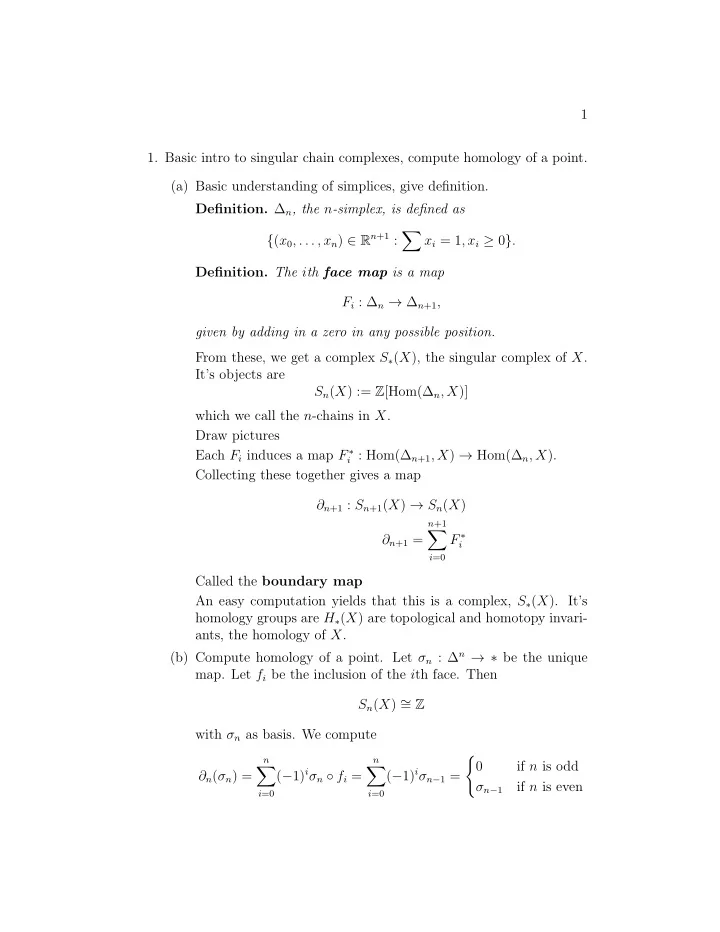

1 1. Basic intro to singular chain complexes, compute homology of a point. (a) Basic understanding of simplices, give definition. Definition. ∆ n , the n -simplex, is defined as { ( x 0 , . . . , x n ) ∈ R n +1 : � x i = 1 , x i ≥ 0 } . Definition. The i th face map is a map F i : ∆ n → ∆ n +1 , given by adding in a zero in any possible position. From these, we get a complex S ∗ ( X ), the singular complex of X . It’s objects are S n ( X ) := Z [Hom(∆ n , X )] which we call the n -chains in X . Draw pictures Each F i induces a map F ∗ i : Hom(∆ n +1 , X ) → Hom(∆ n , X ). Collecting these together gives a map ∂ n +1 : S n +1 ( X ) → S n ( X ) n +1 � F ∗ ∂ n +1 = i i =0 Called the boundary map An easy computation yields that this is a complex, S ∗ ( X ). It’s homology groups are H ∗ ( X ) are topological and homotopy invari- ants, the homology of X . (b) Compute homology of a point. Let σ n : ∆ n → ∗ be the unique map. Let f i be the inclusion of the i th face. Then S n ( X ) ∼ = Z with σ n as basis. We compute n n � 0 if n is odd � � ( − 1) i σ n ◦ f i = ( − 1) i σ n − 1 = ∂ n ( σ n ) = σ n − 1 if n is even i =0 i =0
2 So the singular complex is 0 id 0 . . . 0 Z Z Z Z With homologies . . . 0 0 0 Z 2. Basic covering space stuff (a) Define a covering map/space. Definition. Let ϕ : E → X be a continuous map. Then we say ϕ is a covering map if every point p ∈ X has an evenly covered neighborhood U . This means that ϕ − 1 ( U ) = � α ∈ A U α where ϕ : U α → U is a homeomorphism. Draw pictures. (b) Define classifying space, show BG is Eilenberg-Maclane (long ex- act sequence in homotopy) (c) Define a (proper) group action on a space. Definition. A group action of G on a space X is a homomorphism ρ : G → { Homeomorphisms X → X } Definition. An action ρ is called proper if The resulting quotient X → X/G is a covering map. 3. Prove that if G acts on X , then G acts on S ∗ ( X ), with S ∗ ( X ) G ∼ = S ∗ ( X/G ) (Lemma 6.10.2)
3 π ∗ Proof. We have an obvious map S n ( X ) − → S n ( X/G ) given by compo- π sition with X − → X/g . Suppose we have σ : ∆ n → X and g ∈ G . Then TFDC g σ ∆ n X X X/G Thus, π ∗ descends to the quotient S ∗ ( X ) G → S ∗ ( X/G ). The unique lifting property of covering maps yields that this is an isomorphism. X ∆ n X/G Definition. Let G be a group. Suppose we have a contractible space EG on which G acts properly. Then the quotient space X/G =: BG is called a Classifying space for G . ‘ 4. Theorem 1. Let BG be a classifying space for G . Then the (co)homology of BG is naturally isomorphic to the (co)homology of G . 5. Examples: (a) S 1 as a classifying space for R . (b) RP ∞ as classifying space for Z / 2 (c) B Z /n gives finitely generated abelian groups.
Recommend
More recommend